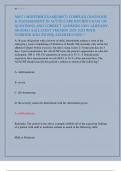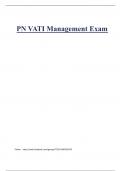1|Pag e
NR571 MIDTERM EXAM|| NR571 COMPLEX DIAGNOSIS
& MANAGEMENT IN ACUTE CARE REVIEW EXAM 100
QUESTIONS AND CORRECT ANSWERS 100% ALREADY
GRADED A+|| LATEST VERSION 2024-2025 WITH
VERIFIED SOLUTIONS|| ASSURED PASS!!!
A 16-year-old patient with a history of mild, intermittent asthma is seen in the
emergency room complaining of shortness of breath. She normally only needs her
albuterol inhaler before exercise, but she is using it now 2-3 times per day for 3
days. Upon examination, the AGACNP notes the patient's appearance as calm but
tachypneic. HR is 108, O2 saturation on room air is 91 %. A bedside peak
expiratory flow measurement reveals FEV1 at 58 % of her personal best. The
AGACNP should classify this patient's asthma as which of the following?
A. mild/moderate
B. severe
C. life-threatening
D. the severity cannot be determined with the information given
A. mild/moderate
Rationale: The patient in the above example exhibits all of the expecting findings
of a patient with mild to moderate asthma as noted in the following table:
Mild or Moderate
,2|Pag e
Talks in phrases, prefers to sit rather than lying down, not agitated, no accessory
muscle use, HR 100-120, O2 saturation 90-95 % on room air
> 50% of predicted or personal best
Severe
Talks in words, leans forward when sitting, appears agitated, RR>30/min,
accessory muscle usage, HR>120, O2 saturation< 90% on room air
< 50 % of predicted or personal best
Life-threatening
Unable to speak, drowsy, or confused
n/a
A 52-year-old male patient has been admitted to the heart failure unit with new
atrial fibrillation (AF), volume overload, and hypoxia. This is his first admission
for heart failure (HF), and during intake he denies a past medical history of
hypertension, hyperlipidemia, or myocardial infarction. All of the patient's
immediate family members are alive and well. There is no family history of heart
disease, sudden death, or infiltrative disease. The patient jogs regularly and denies
anginal symptoms or syncope. The patient endorses alcohol use for 20 years and
states that he has tried to cut down recently. Based on this information, what is the
most likely cause of the patient's new heart failure?
,3|Pag e
A.Ischemic dilated cardiomyopathy
B.Hypertrophic cardiomyopathy
C.Restrictive cardiomyopathy
D.Takotsubo cardiomyopathy
Answer: A. Ischemic dilated cardiomyopathy
The patient’s presentation is most consistent with ischemic dilated cardiomyopathy
related to alcohol use. Ischemic dilated cardiomyopathy is more common in men
and often presents with development of arrythmia like AF. His only risk factor for
heart failure is alcohol use, which is a secondary cause of ischemic dilated
cardiomyopathy. Hypertrophic cardiomyopathy is often asymptomatic at rest,
although symptoms may occur during strenuous exercise. It most commonly
presents in those in the third decade of life. Additionally, hypertrophic
cardiomyopathy runs in families, and the patient denies any history of heart disease
in his family. Restrictive cardiomyopathy is associated with a number of etiologies,
including infiltrative disease, which the patient denies. It also presents with a
history of poor exercise tolerance, which is not consistent with the patient’s history
of present illness. Takotsubo cardiomyopathy is associated with extreme emotional
stress and often manifests with anginal symptoms, which does not fit the patient’s
presentation.
Adults with a history of congenital heart disease (CHD) are at risk of what
common complication?
A.Deep vein thrombosis (DVT)
B.Myocardial infarction
C.Heart failure
D.Stillbirth
Answer: C. Heart failure
, 4|Pag e
Patients with a diagnosis of CHD are monitored frequently for the development of
heart failure. While DVT can be a result of an unrepaired congenital heart defect,
this is not considered a common complication in most adults. Myocardial
infarction is not a frequent complication in CHD. Some women with a concurrent
diagnosis of CHD and pulmonary arterial hypertension (PAH) are counseled
against pregnancy due to the risk of maternal death; however, development of heart
failure is of concern to a wider group of these patients.
While rounding on a 70-year-old patient recently admitted with community-
acquired pneumonia, the AGACNP notes an ulcer on the medial malleolus. The
ulcer bed is shallow, and the borders are irregular. The surrounding skin is notable
for hemosiderin staining, with +1 edema to both lower extremities. What is the
most appropriate treatment?
A.Compression therapy, wound care consult, and elevation of the affected limb
B.Pain control, debridement, and surgical consult
C.Wound care consult, frequent position changes, and a pressure-reducing mattress
D.Antibacterial ointment, wet to dry dressing, and wound care consult
Answer: A. Compression therapy, wound care consult, and elevation of the
affected limb
A shallow-based ulcer with uneven edges present at the medial malleolus is
consistent with venous statis. Compression therapy and elevation are mainstays of
treatment. Pain control, debridement, and surgical consult are indicated in the
management of arterial ulcers, whereas the patient’s symptoms and signs are more
consistent with an ulcer related to venous insufficiency. Frequent position changes
and a pressure-reducing mattress are appropriate in the setting of a pressure ulcer,
not a venous ulcer. Compression dressings, not wet to dry dressings, are the





